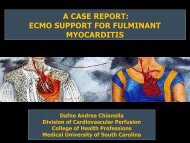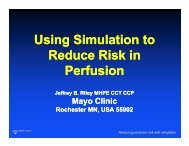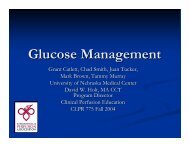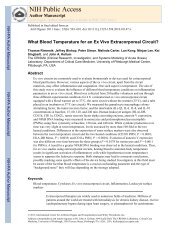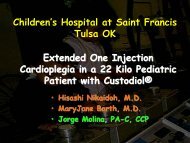PowerPoint Presentation (PDF) - Perfusion.com
PowerPoint Presentation (PDF) - Perfusion.com
PowerPoint Presentation (PDF) - Perfusion.com
Create successful ePaper yourself
Turn your PDF publications into a flip-book with our unique Google optimized e-Paper software.
A Cardiopulmonary Bypass Technique to<br />
Physiologically Abate the Deleterious<br />
Effects of Gaseous Microemboli<br />
Kristina Schmidt, BS<br />
Carrie Whittaker, MPS, CCP, FFP<br />
David Holt, MA, CCT<br />
University of Nebraska Medical Center, Omaha, NE
University of Nebraska Medical Center<br />
Objectives<br />
• Background<br />
• Hypothesis<br />
• Materials<br />
• Methods<br />
• Results<br />
• Conclusion<br />
• Study Limitations<br />
• References
University of Nebraska Medical Center<br />
Introduction<br />
• Neurocognitive impairment is a serious <strong>com</strong>plication of bypass and can be caused by<br />
gaseous or particulate emboli (1).<br />
• Possible neurologic <strong>com</strong>plications include stroke, <strong>com</strong>a, seizures, and memory<br />
impairment (2).<br />
• There are a plethera of ways for air to be introduced into the blood as it circulates<br />
through the perfusion circuit. Several include excessive suction, cavitation at turbulent<br />
regions of the circuit, mechanical jarring, and direct injection of gas by drug<br />
administration or other methods (3).<br />
• GME behavior within the extracorporeal circuit is multi-factorial. There is a <strong>com</strong>plex<br />
interrelationship between such factors as flow, gaseous partial pressure, volume,<br />
solubility, buoyancy, perfusate, temperature, fluid viscosity, and ECC circuit design (19).
University of Nebraska Medical Center<br />
http://static.howstuffworks.<strong>com</strong>/gif/define-pulmonary-embolism-1.jpg<br />
http://www.sciencedaily.<strong>com</strong>/images/2006/07/060721195718.jpg
University of Nebraska Medical Center<br />
Introduction<br />
• Hyperoxia refers to using supraphysiologic levels of oxygen (21).<br />
• One of the reasons that perfusionists use hyperoxia is to prevent against the<br />
delivery of insoluble nitrogen bubbles to the body from the bypass circuit to<br />
the patient (5).<br />
• Running higher FiO 2 levels during cardiopulmonary bypass (CPB) increases<br />
the partial pressure of oxygen in the blood, in turn reducing the partial<br />
pressure of nitrogen.<br />
• Alteration of the <strong>com</strong>position of gaseous microbubbles through the use of<br />
hyperoxia can help to prevent the delivery of nitrogenous bubbles to the<br />
patient.
University of Nebraska Medical Center<br />
Henry’s Law<br />
At a constant temperature, the amount of a given gas<br />
dissolved in a given type and volume of liquid is directly<br />
proportional to the partial pressure of that gas in equilibrium<br />
with that liquid (13).
University of Nebraska Medical Center<br />
Hypothesis<br />
The purpose of the study is to demonstrate that hyperoxia<br />
can be a protective mechanism during CPB, due to the<br />
saturation of GME with easily absorbed and more soluble<br />
oxygen, by varying FiO 2 delivery to affect the solution’s<br />
partial pressures of oxygen and subsequently nitrogen.
University of Nebraska Medical Center<br />
Materials<br />
• 250 cc 0.9% sodium chloride injection<br />
• Cincinnati Sub-Zero Hemotherm cooler/heater, Model 400MR<br />
• BioMedicus centrifugal pump, Model 540<br />
• Terumo Capiox SX25 Hollow Fiber Oxygenator<br />
• ½ inch tubing<br />
• BioMedicus centrifugal pump, Model 540<br />
• BioMedicus BioProbe transducer Model TXOP<br />
• BioMedicus centrifugal cone<br />
• Medtronic Minimax bag reservoir<br />
• Sechrist air-oxygen mixer<br />
• Tubing clamps<br />
• Monoject 3ml syringes<br />
• Temperature monitor and probe on a Stockert III heart lung machine<br />
• Bayer Rapid Point Blood-Gas Analysis
University of Nebraska Medical Center
University of Nebraska Medical Center
University of Nebraska Medical Center<br />
Methods<br />
• Assembled and primed circuit with 250 cc NaCl.<br />
• Turned heater/cooler to 37 degrees C and attached temperature probe to<br />
oxygenator.<br />
• Set flow and sweep on a 1:1 ratio of 2 L/min.<br />
• Testing points were randomized for the following FiO 2 s: 21, 50, 60, 70, 80,<br />
90, and 100%.<br />
• After 20 minutes of recirculating at the desired FiO 2 , 1.5cc of fluid was<br />
withdrawn from the luer port on the top of the venous bag.<br />
• Blood-gas analysis to obtain the PO 2 of the sample.<br />
• Mathematical derivation of PN 2 and solubility of both gases.
University of Nebraska Medical Center<br />
Sample Size<br />
• The data for this experiment was collected via a series of 21 separate runs<br />
using 7 different levels of FiO 2 with 3 runs at each level.<br />
• Conducting three tests at each level of FiO 2 was sufficient. The positive<br />
association seen in the initial pilot trial was strong and doing 3 tests at each<br />
level helped to provide an estimate of test variability at each level and<br />
helped to minimize Type II errors.<br />
• The order of the runs was randomized to minimize any random interference<br />
that could be related to the ordering (see next slide).
University of Nebraska Medical Center<br />
Randomized numbering<br />
1st time through - 0.9 0.7 0.6 1.0 0.21 0.8 0.5<br />
2nd time through - 0.5 0.6 0.7 1.0 0.9 0.21 0.8<br />
3rd time through - 0.5 0.9 0.8 0.7 0.21 0.6 1.0
University of Nebraska Medical Center<br />
Calculating Solubility<br />
• Air: 78% N 2 , 21% O 2<br />
• At 37 degrees C and 1atm (14)…<br />
N 2 solubility= .015 ml/mmHg/L<br />
O 2 solubility= .030 ml/mmHg/L<br />
http://www.bbc.co.uk/schools/gcsebitesize/science/im<br />
ages/50_<strong>com</strong>position_of_the_earth.gif
University of Nebraska Medical Center
University of Nebraska Medical Center<br />
Calculating Solubility<br />
• The solubility of O 2 (in ml/L) was calculated with the following<br />
equation:<br />
= (PO 2 mmHg)(.03 ml/mmHg/L)<br />
• The solubility of N 2 (in ml/L) was calculated with the following<br />
equation:<br />
=(740 mmHg - PO 2 mmHg)(.015 ml/mmHg/L)<br />
…where 740 mmHg was the atmospheric pressure in Kansas City<br />
on the day of the experiment.
University of Nebraska Medical Center<br />
Assumptions<br />
• It was assumed that the resulting partial pressure of oxygen would increase<br />
linearly as the level of FiO 2 used in the hyperoxia process was increased.<br />
• A linear increase was also assumed for the solubility of oxygen while a linear<br />
decrease was assumed for the solubility of nitrogen.<br />
• As the solubility of oxygen and nitrogen are linear functions of the partial<br />
pressure of oxygen for a given temperature and atmospheric pressure, if any<br />
one of these three assumptions is correct, then all must be correct.
University of Nebraska Medical Center<br />
Table 1<br />
FiO 2<br />
Baseline 0.21 0.5 0.6 0.7 0.8 0.9 1.0<br />
PO 2 (mmHg)<br />
Trial 1 174.3 243.0 303.8 374.4 396.9 422.5 569.5 675.8<br />
Trial 2 170.2 253.7 300.5 377.2 411.8 432.8 583.6 659.0<br />
Trial 3 173.2 237.0 289.7 365.4 399.2 439.2 579.9 661.6<br />
Mean (sd) 172.6 (2.1) 244.6 (8.5) 298 (7.4) 372.3 (6.2) 402.6 (8) 431.5 (8.4) 577.7 (7.3) 665.5 (9)<br />
Solubility O 2 (ml/L)<br />
Trial 1 5.23 7.29 9.11 11.23 11.91 12.68 17.09 20.27<br />
Trial 2 5.11 7.61 9.02 11.32 12.35 12.98 17.51 19.77<br />
Trial 3 5.20 7.11 8.69 10.96 11.98 13.18 17.40 19.85<br />
Mean (sd) 5.18 (0.06) 7.34 (0.25) 8.94 (0.22) 11.17 (0.18) 12.08 (0.24) 12.95 (0.25) 17.33 (0.22) 19.96 (0.27)<br />
Solubility N 2 (ml/L)<br />
Trial 1 8.49 7.46 6.54 5.48 5.15 4.76 2.56 0.96<br />
Trial 2 8.55 7.29 6.59 5.44 4.92 4.61 2.35 1.22<br />
Trial 3 8.50 7.55 6.75 5.62 5.11 4.51 2.40 1.18<br />
Mean (sd) 8.51 (0.03) 7.43 (0.13) 6.63 (0.11) 5.52 (0.09) 5.06 (0.12) 4.63 (0.13) 2.44 (0.11) 1.12 (0.14)
University of Nebraska Medical Center<br />
Results<br />
• The measured PO 2 values increased proportionally to the FiO 2 values, and<br />
were used to calculate the solubility of both nitrogen and oxygen in the fluid.<br />
• The results demonstrated that the calculated solubility of oxygen increased<br />
from an FiO 2 of 21 to 100% (an average of 5.177 ml/L to 19.964 ml/L,<br />
respectively.)<br />
• In turn, the calculated solubility of nitrogen decreased with an increase in<br />
FiO 2 (8.5115 ml/L and 1.118 ml/L, respectively.)
University of Nebraska Medical Center<br />
Measured Results: FiO 2 vs. PO 2<br />
700<br />
600<br />
500<br />
PO 2<br />
400<br />
300<br />
200<br />
100<br />
0<br />
Trial 1<br />
Trial 2<br />
Trial 3<br />
0 0.2 0.4 0.6 0.8 1 1.2<br />
FiO 2
Solubility O 2 (ml/L)<br />
University of Nebraska Medical Center<br />
Calculated Results: FiO 2 vs. Solubility of O 2<br />
25<br />
20<br />
15<br />
10<br />
5<br />
0<br />
Trial 1<br />
Trial 2<br />
Trial 3<br />
0 0.2 0.4 0.6 0.8 1 1.2<br />
FiO 2
Solubility N 2 (ml/L)<br />
University of Nebraska Medical Center<br />
Calculated Results: FiO 2 vs. Solubility of N 2<br />
8<br />
7<br />
6<br />
5<br />
4<br />
3<br />
2<br />
1<br />
0<br />
Trial 1<br />
Trial 2<br />
Trial 3<br />
0 0.2 0.4 0.6 0.8 1 1.2<br />
FiO 2
University of Nebraska Medical Center<br />
Statistical Analysis<br />
• An Ordinary Least Squares Regression (OLS Regression) was performed to<br />
test for an association between the FiO 2 level and the partial pressure of<br />
oxygen, solubility of oxygen, and solubility of nitrogen.<br />
• This regression results allow t-test analysis to determine if the coefficients in<br />
the model are significantly different from zero.<br />
• In each of the three regression models, the coefficient for the slope of the<br />
linear association between the FiO 2 level and each of the three out<strong>com</strong>es<br />
was significantly different from zero, suggesting that there is a relationship<br />
between the FiO 2 level and each of the three out<strong>com</strong>es.
University of Nebraska Medical Center<br />
Table 2: Linear Regression Results (N=21)<br />
Coefficient<br />
Estimates<br />
PO 2 (mmHg)<br />
Intercept<br />
(se)<br />
74.6<br />
(32.4)<br />
p-value<br />
0.03<br />
FiO 2<br />
(se)<br />
524.5<br />
(45.2)<br />
p-value<br />
University of Nebraska Medical Center<br />
Discussion<br />
• This research experiment reinforced the accepted theory that PO 2<br />
will increase as FiO 2 increases.<br />
• The calculated data also showed a correlation that perhaps many<br />
perfusionists do not think of- the affect that FiO 2 has on the solubility<br />
of gases and GME.<br />
• Amidst the controversy of hyperoxia, the author of this study aimed<br />
to show how a high oxygen tension can be beneficial to patients in<br />
which GME are suspected.
University of Nebraska Medical Center<br />
Discussion<br />
• The authors do, however, recognize there are certain instances where 100% FiO 2 s<br />
should not be used.<br />
• Reperfusion injury occurs when antioxidants are deactivated during cellular acidosis<br />
from ischemia followed by capillary reperfusion with warm, oxygenated blood (16).<br />
• Many hospitals have changed their protocols to normoxic perfusion because of studies<br />
suggesting increased myocardial injury by free radicals during and after hyperoxia (8).<br />
• A high PO 2 after cross- clamp removal could result in increased generation of<br />
deleterious free radical species, but oxygen loading before any period of ischemia might<br />
negate that risk (21).
University of Nebraska Medical Center<br />
Discussion<br />
• Another argument against the use of hyperoxia during surgery is that it may<br />
exacerbate retrolental fibroplasia.<br />
• This is caused by long-term exposure to elevated PaO 2 . It is typically due to<br />
prolonged ventilatory requirements of premature neonates and is not<br />
generally a concern in the time length of CPB.<br />
• In reality, a change to 100% FiO 2 will not drastically increase the amount of<br />
oxygen the patient receives.<br />
• The amount of oxygen available to the tissues that can cause reperfusion<br />
injury is much more dependent on the hemoglobin concentration than the<br />
sweep FiO 2 (6).
University of Nebraska Medical Center<br />
Study Limitations<br />
• A non-blood prime was used.<br />
• In blood, bubbles be<strong>com</strong>e coated with protein, and this affects how<br />
bubbles move through solution.<br />
• In the future, a similar experiment should be done using blood to<br />
avoid any possible data corruption.
University of Nebraska Medical Center<br />
Study Limitations<br />
• Originally, the authors of this study had planned to conduct the<br />
experiment differently.<br />
• The initial methods involved injecting a bolus of room air, which is<br />
primarily <strong>com</strong>posed of nitrogen, into the venous bag reservoir.<br />
• The idea was to draw up the bubble into an oxygen analyzer to see<br />
if the bubble had changed its <strong>com</strong>position during hyperoxic<br />
circulation.<br />
http://www.fetamed.<strong>com</strong>/images/MiniOx_Oxygen_Analyzer.gif
University of Nebraska Medical Center<br />
Conclusion<br />
• While many perfusionists and surgeons consistently use a certain<br />
oxygenation strategy regardless of patient parameters, a high FiO 2<br />
may be beneficial when it <strong>com</strong>es to fighting air emboli.<br />
• This study focused on hyperoxia and its direct effect on preventing<br />
the harmful consequences of GME. Further research is needed to<br />
study hyperoxia’s effects on this topic, as well as the other benefits<br />
or possible deleterious effects this gas strategy may have.
University of Nebraska Medical Center<br />
References<br />
1. Gaseous Micro Emboli: Concepts and Considerations. Butler, BD. 2006, JECT, Vol. 38, pp. 271-279.<br />
2. An In Vitro Study of the Effectiveness of Carbon Dioxide Flushing of Arterial Line Filters. Beckman, R., Gisner, C.,<br />
Evans, E. JECT, Vol. 41, pp. 161-165.<br />
3. Attenuation of Neurologic Injury During Cardiac Surgery. Murkin, JM. 2001, Annals of Thoracic Surgery, Vol. 72, pp.<br />
1838-34.<br />
4. Clinically silent cerebral ischemic events after cardiac surgery: their incidence, regional vascular occurrence, and<br />
procedural dependence. Floyd TF, Shah PN, Price CC, et al. The Annals of Thoracic Surgery, Vol. 81, pp.<br />
2160-6.<br />
5. Gas embolism: pathophysiology and treatment. Van Hulst RA, Klein J, Lachmann B. 2003, Clin Physiol Funct<br />
Imaging, pp. 26-237.<br />
6. Gaseous Microemboli and Hyperoxia. Grist, G. 2006, JECT, pp. 367-369.<br />
7. Solubility. Bookrags. [Online] 2005. [Cited: December 6, 2009.] http://www.bookrags.<strong>com</strong>/research/solubility-woc/.<br />
8. Oxygenation Strategy and Neurologic Damage After Deep Hypothermic Circulatory Arrest. II. Hypoxic Versus Free<br />
Radical Injury. Nollert, G., et al. 1999, The Journal of Thoracic and Cardiovascular Surgery, pp. 1172-1179.<br />
9. Whittaker, C. Email correspondence. 2008.<br />
10. Gaseous Microemboli and the Influence of Microporous Membrane Oxygenators. Weitkemper, H., Oppermann, B.,<br />
Spilker, A., Knobl, H., Reiner, K. 2005, JECT, pp. 256-264.
University of Nebraska Medical Center<br />
11. The Theoretical Prediction of Safe Deep Hypothermic Circulatory Arrest (DHCA) Time Using Estimated Tissue<br />
Oxygen Loading. Whittaker, C., Grist, G. 2008, Progess in Pediatric Cardiology, pp. 117-122.<br />
12. Postoperative Management of Cerebral Air Embolism: Gas Physiology For Surgeons. Tovar EA., Del Campo C.,<br />
Borsari A., et al. 1995, Annals of Thoracic Surgery, pp. 1138-1142.<br />
13. Pauling, Linus. General Chemistry. s.l. : Dover Publications, 1988.<br />
14. Durrant, Philip John. General and Inorganic Chemistry. 1939, p. 168.<br />
15. Commerce, U.S. Department of. National Oceanic and Atmospheric Administration. National Weather Service.<br />
[Online] October 5, 2009. http://www.nws.noaa.gov.<br />
16. Myocardial Reperfusion Injury: Etiology, Mechanisms, and Therapies. Hoffman Jr JW., Gilbert TB., Poston RS.,<br />
Silldorff EP. 2004, JECT, pp. 391-411.<br />
17. Normoxia vs. Hyperoxia: Impact of Oxygen Tension Strategies on Out<strong>com</strong>es for Patients Receiving Cardiopulmonary<br />
Bypass for Routine Cardiac Surgical Repair. Brown, M., Holt, D., Edwards, J., Burnett, R. 2006, JECT, pp.<br />
241-248.<br />
18. Wallace, O. What is Retrolental Fibroplasia. Wise Geek. [Online] 2009. [Cited: March 30, 2009.]<br />
http://www.wisegeek.<strong>com</strong>/what-is-retrolental-fibroplasia.htm.<br />
19. Emboli Generation by the Medtronic Maxima Hardshell Adult Venous Reservoir in Cardiopulmonary Bypass Circuits:<br />
A Preliminary Report. Mitchell, S. J., Wilcox, T., McDougal, C., Gorman, D. F. 1996, <strong>Perfusion</strong>, Vol. 11, pp.<br />
145-155.<br />
20. Air Solubility in Water. Engineering Tool Box. [Online] 2005. [Cited: December 6, 2009.]<br />
http://www.engineeringtoolbox.<strong>com</strong>/gases-solubility-water-d_1148.html.<br />
21. Effects of Hyperoxia on Neonatal Myocardial Energy Status and Response to Global Ischemia. Wittnich, C., Torrance, S., Carlyle,<br />
C. 2000, The Society of Thoracic Surgeons, pp. 2125-31.



